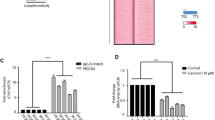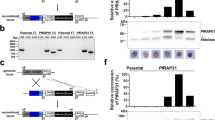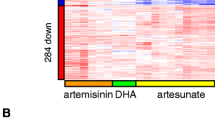Abstract
Malaria is a deadly, infectious disease caused by the parasite Plasmodium, leading to millions of deaths worldwide. Plasmodium requires a coordinated pattern of sequential gene expression for surviving in both invertebrate and vertebrate host environments. As parasites largely depend on host resources, they also develop efficient mechanisms to sense and adapt to variable nutrient conditions in the environment and modulate their virulence. Earlier we have shown that PfGCN5, a histone acetyltransferase, binds to the stress-responsive and virulence-related genes in a poised state and regulates their expression under temperature and artemisinin treatment conditions in P. falciparum. In this study, we show upregulation of PfGCN5 upon nutrient stress condition. With the help of chromatin immunoprecipitation coupled high-throughput sequencing (ChIP-seq) and transcriptomic (RNA-sequencing) analyses, we show that PfGCN5 is associated with the genes that are important for the maintenance of parasite cellular homeostasis upon nutrient stress condition. Furthermore, we identified various metabolic enzymes as interacting partners of PfGCN5 by immunoprecipitation coupled with mass spectroscopy, possibly acting as a sensor of nutrient conditions in the environment. We also demonstrated that PfGCN5 interacts and acetylates PfGAPDH in vitro. Collectively, our data provides important insights into transcriptional deregulation upon nutrient stress condition and elucidate the role of PfGCN5 during nutrient stress condition.





Similar content being viewed by others
References
Abel S and Le Roch KG 2019 The role of epigenetics and chromatin structure in transcriptional regulation in malaria parasites. Brief Funct. Genomics 18 302–313
Aly AS, Vaughan AM and Kappe SH 2009 Malaria parasite development in the mosquito and infection of the mammalian host. Annu. Rev. Microbiol. 63 195–221
Babbitt SE, Altenhofen L, Cobbold SA, Istvan ES, Fennell C, Doerig C, Llinás M and Goldberg DE 2012 Plasmodium falciparum responds to amino acid starvation by entering into a hibernatory state. Proc. Natl. Acad. Sci. 109 E3278–E3287
Becker K, Tilley L, Vennerstrom JL, Roberts D, Rogerson S and Ginsburg H 2004 Oxidative stress in malaria parasite-infected erythrocytes: host–parasite interactions. Int. J. Parasitol. 34 163–189
Billker O, Lindo V, Panico M, Etienne A, Paxton T, Dell A, Rogers M, Sinden R and Morris H 1998 Identification of xanthurenic acid as the putative inducer of malaria development in the mosquito. Nature 392 289
Blader IJ, Manger ID and Boothroyd JC 2001 Microarray analysis reveals previously unknown changes in Toxoplasma gondii-infected human cells. J. Biol. Chem. 276 24223–24231
Cobbold SA, Santos JM, Ochoa A, Perlman DH and Llinás M 2016 Proteome-wide analysis reveals widespread lysine acetylation of major protein complexes in the malaria parasite. Sci. Rep. 6 19722
Coleman BI and Duraisingh MT 2008 Transcriptional control and gene silencing in Plasmodium falciparum. Cell Microbiol. 10 1935–1946
Dean S, Marchetti R, Kirk K and Matthews KR 2009 A surface transporter family conveys the trypanosome differentiation signal. Nature 459 213
Decherf G, Egée S, Staines HM, Ellory JC and Thomas SL 2004 Anionic channels in malaria-infected human red blood cells. Blood Cell. Mol. Dis. 32 366–371
Engelbrecht D and Coetzer T 2013 Turning up the heat: heat stress induces markers of programmed cell death in Plasmodium falciparum in vitro. Cell Death Dis. 4 e971
Gardner MJ, Hall N, Fung E, White O, Berriman M, Hyman RW, Carlton JM, Pain A, Nelson KE and Bowman S 2002 Genome sequence of the human malaria parasite Plasmodium falciparum. Nature 419 498
Goldberg DE, Slater A, Cerami A and Henderson GB 1990 Hemoglobin degradation in the malaria parasite Plasmodium falciparum: an ordered process in a unique organelle. Proc. Natl. Acad. Sci. 87 2931–2935
Gomez-Arreaza A, Acosta H, Quinones W, Concepción JL, Michels PA and Avilan L 2014 Extracellular functions of glycolytic enzymes of parasites: unpredicted use of ancient proteins. Mol. Biochem. Parasitol. 193 75–81
Kanyal A, Rawat M, Gurung P, Choubey D, Anamika K and Karmodiya K 2018 Genome-wide survey and phylogenetic analysis of histone acetyltransferases and histone deacetylases of Plasmodium falciparum. FEBS J. 285 1767–1782
Karmodiya K, Pradhan SJ, Joshi B, Jangid R, Reddy PC and Galande S 2015 A comprehensive epigenome map of Plasmodium falciparum reveals unique mechanisms of transcriptional regulation and identifies H3K36me2 as a global mark of gene suppression. Epigenetics Chromatin 8 32
Ke H, Lewis IA, Morrisey JM, McLean KJ, Ganesan SM, Painter HJ, Mather MW, Jacobs-Lorena M, Llinás M and Vaidya AB 2015 Genetic investigation of tricarboxylic acid metabolism during the Plasmodium falciparum life cycle. Cell Rep. 11 164–174
Kim S-K., Fouts AE and Boothroyd JC 2007 Toxoplasma gondii dysregulates IFN-γ-inducible gene expression in human fibroblasts: insights from a genome-wide transcriptional profiling. J. Immunol. 178 5154–5165
Lang C, Groß U and Lüder CG 2007 Subversion of innate and adaptive immune responses by Toxoplasma gondii. Parasitol. Res. 100 191–203
MacRae JI, Dixon MW, Dearnley MK, Chua HH, Chambers JM, Kenny S, Bottova I, Tilley L and McConville MJ 2013 Mitochondrial metabolism of sexual and asexual blood stages of the malaria parasite Plasmodium falciparum. BMC Biol. 11 67
Mancio-Silva L, Slavic K, Ruivo MTG, Grosso AR, Modrzynska KK, Vera IM, Sales-Dias J, Gomes AR, MacPherson CR and Crozet P 2017 Nutrient sensing modulates malaria parasite virulence. Nature 547 213
Martin RE and Kirk K 2007 Transport of the essential nutrient isoleucine in human erythrocytes infected with the malaria parasite Plasmodium falciparum. Blood 109 2217–2224
Miao J, Lawrence M, Jeffers V, Zhao F, Parker D, Ge Y, Sullivan Jr WJ and Cui L 2013 Extensive lysine acetylation occurs in evolutionarily conserved metabolic pathways and parasite-specific functions during Plasmodium falciparum intraerythrocytic development. Mol. Microbiol. 89 660–675
Oakley MS, Kumar S, Anantharaman V, Zheng H, Mahajan B, Haynes JD, Moch JK, Fairhurst R, McCutchan TF and Aravind L 2007 Molecular factors and biochemical pathways induced by febrile temperature in intraerythrocytic Plasmodium falciparum parasites. Infect. Immun. 75 2012–2025
Olszewski KL, Morrisey JM, Wilinski D, Burns JM, Vaidya AB, Rabinowitz JD and Llinás M 2009 Host-parasite interactions revealed by Plasmodium falciparum metabolomics. Cell Host Microbe 5 191–199
Percário S, Moreira D, Gomes B, Ferreira M, Gonçalves A, Laurindo P, Vilhena T, Dolabela M and Green M 2012 Oxidative stress in malaria. Int. J. Mol. Sci. 13 16346–16372
Plattner F and Soldati-Favre D 2008 Hijacking of host cellular functions by the Apicomplexa. Annu. Rev. Microbiol. 62 471–487
Rawat M, Kanyal A, Sahasrabudhe A, Vembar SS, Lopez-Rubio J-J and Karmodiya K 2019a PfGCN5, a global regulator of stress responsive genes, modulates artemisinin resistance in Plasmodium falciparum. biorXiv:679100
Rawat M, Srivastava A, Gupta I and Karmodiya K 2019b Single Cell RNA-sequencing reveals cellular heterogeneity, stage transition and antigenic variation during stress adaptation in synchronized Plasmodium falciparum. biorXiv:752543
Rosenberg E, Ben-Shmuel A, Shalev O, Sinay R, Cowman A and Pollack Y 2009 Differential, positional-dependent transcriptional response of antigenic variation (var) genes to biological stress in Plasmodium falciparum. PLoS One 4 e6991
Singh AP, Buscaglia CA, Wang Q, Levay A, Nussenzweig DR, Walker JR, Winzeler EA, Fujii H, Fontoura BM and Nussenzweig V 2007 Plasmodium circumsporozoite protein promotes the development of the liver stages of the parasite. Cell 131 492–504
Srivastava A, Philip N, Hughes KR, Georgiou K, MacRae JI, Barrett MP, Creek DJ, McConville MJ and Waters AP 2016 Stage-specific changes in Plasmodium metabolism required for differentiation and adaptation to different host and vector environments. PLoS Pathogens 12 e1006094
Ting L-M, Shi W, Lewandowicz A, Singh V, Mwakingwe A, Birck MR, Ringia EAT, Bench G, Madrid DC and Tyler PC 2005 Targeting a novel Plasmodium falciparum purine recycling pathway with specific immucillins. J. Biol. Chem. 280 9547–9554
Ventura M, Mateo F, Serratosa J, Salaet I, Carujo S, Bachs O and Pujol MJ 2010 Nuclear translocation of glyceraldehyde-3-phosphate dehydrogenase is regulated by acetylation. Int. J. Biochem. Cell Biol. 42 1672–1680
World Health Organization 2018 World Malaria Report 2018. Geneva
Zuzarte-Luís V and Mota MM 2018 Parasite sensing of host nutrients and environmental cues. Cell Host Microbe 23 749–758
Acknowledgements
This work was supported by Genome Engineering Technologies program (BT/PR25858/GET/119/169/2017) of the Department of Biotechnology, India, to KK. MR is supported by the DBT-SRF fellowship. The funders had no role in study design, data collection and analysis, decision to publish, or preparation of the manuscript.
Author information
Authors and Affiliations
Corresponding author
Additional information
This article is part of the Topical Collection: Chromatin Biology and Epigenetics.
Electronic supplementary material
Below is the link to the electronic supplementary material.
Supplementary Figure 1.
Venn diagram showing number of genes bound by PfGCN5 during control and nutrient stress conditions. Genes associated with antigenic variation and immune response were found to be targets of PfGCN5 under both control and nutrient stress conditions. PfGCN5 was bound to metabolic genes exclusively during nutrient stress condition. (DOCX 179 kb)
Rights and permissions
About this article
Cite this article
Rawat, M., Malhotra, R., Shintre, S. et al. Role of PfGCN5 in nutrient sensing and transcriptional regulation in Plasmodium falciparum. J Biosci 45, 11 (2020). https://doi.org/10.1007/s12038-019-9981-4
Published:
DOI: https://doi.org/10.1007/s12038-019-9981-4




